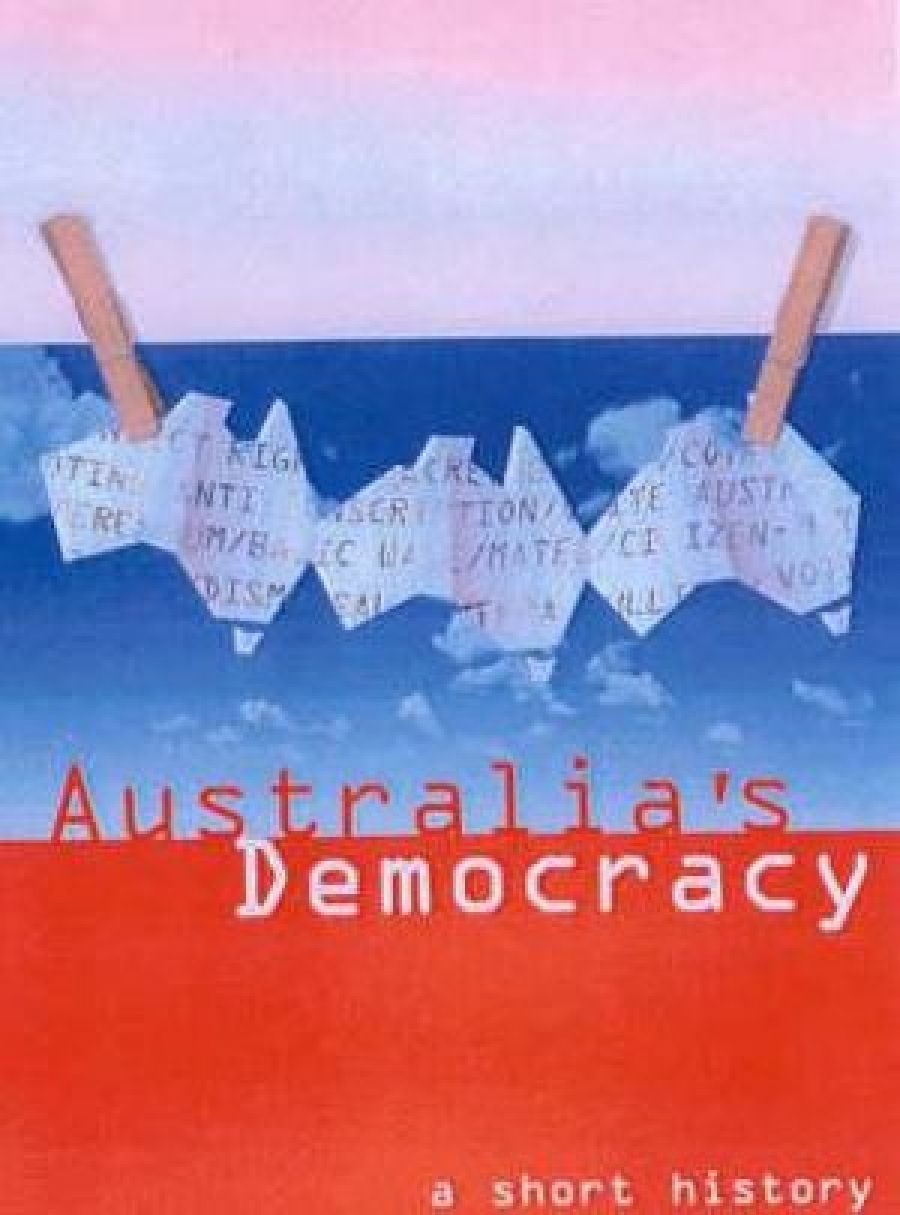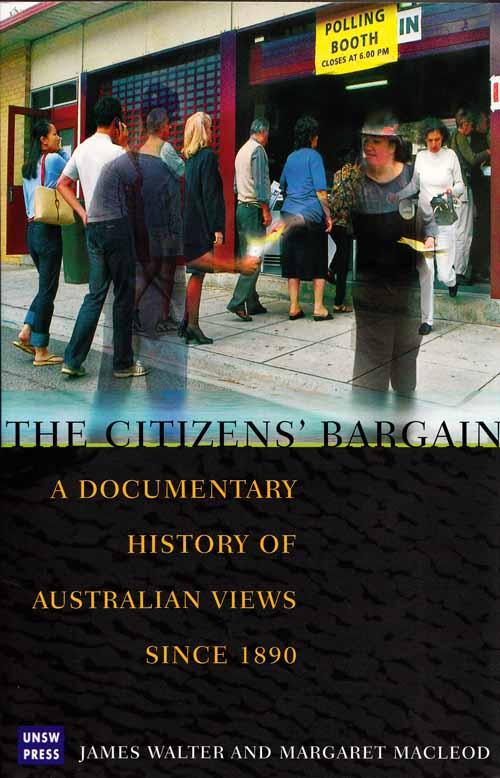
- Free Article: No
- Contents Category: History
- Review Article: Yes
- Online Only: No
- Custom Highlight Text:
John Hirst faced a challenging task when he set out to write Australia’s Democracy: A short history. In a single monograph, he has traced the story of political rights and practices of citizenship, assessed within a context of social change. Not only does such writing place considerable demands on a historian’s range, but any prominent historian who attempts a short history attracts the sharp attention of all stakeholders. In Hirst’s case, his position as chair of the Commonwealth Government’s Civics Education Group has contributed further to his high profile in recent discussion on the need for citizenship training. Australia’s Democracy was funded by the Department of Education, Science and Training, and made available to schools for the ‘Discovering Democracy’ programme. Few historians write while carrying so much responsibility towards their prospective readership.
- Book 1 Title: Australia’s Democracy
- Book 1 Subtitle: A short history
- Book 2 Title: The Citizens’ Bargain
- Book 2 Subtitle: A documentary history of Australian views since 1890
- Book 2 Cover Small (400 x 600):

- Book 2 Cover (800 x 1200):

- Book 2 Cover Path (no longer required): images/1_SocialMedia/2021/Jan_2021/META/30006158205.jpg
Such histories are sensitive indicators of the state of play in national historiographies. Favoured histories of democracy in the United States, for example, commonly portray a triumphalist progression from the darkness of autocracy to the light of universal suffrage (with a few rather unfortunate interludes). Recent studies – notably, Alexander Keyssar’s The Right to Vote: A contested history of democracy in the United States (2000) and Evelyn Nakano Glenn’s Unequal Freedom: How race and gender shaped American citizenship and labor (2002) – demonstrate how fresh critical enquiry on democracy illuminates the complexities of social power in relation to ethnicity, race, gender, and class. These categories may flow easily from the academic’s pen; but millions of people past and present have been aware, sometimes painfully, of how meaningful they were for their own life chances, and those of their kith and kin. A country’s passage to democracy affords a particularly sensitive entry to understanding the position of the various social groups within its borders, and for identifying those in a position to determine people’s fates – who was included, who excluded – at different times and places.
Issues such as these assume even greater resonance in 2002 as we commemorate notable moments in human rights in this country. It has been the centenary of white women’s access to federal political rights, and forty years since Indigenous men and women were similarly enfranchised. Influential scholarship in these and other areas published in the past two decades has raised serious questions about democratic rules and practices back to the days of the first colonial legislatures, stressing their contested character and the chequered nature of groups’ political transitions. Academic research, supplemented by popular historical writing and published personal testimony, now emphasises the stark anomalies that marred Australia’s democratic pretensions well into the twentieth century. A revisionist ‘short’ history in the light of this new scholarship would be extremely timely.
Australia’s Democracy is not that book. For all its sturdy 360 pages (a somewhat weighty ‘brief history’), the book offers no new synthesis. As a conscientious historian, Hirst is aware of recent writing concerning marginalised groups and, almost dutifully, records it throughout. The deeper implications of the new research for reframing the main narrative of Australian history, however, escape him. His is basically a traditional vision that has continued, perhaps a little ruffled by findings hostile to a congenial interpretation of white politics, but not sufficiently disturbed to engage in a fundamental reassessment. Hirst offers in this book a reworked but eminently recognisable story of how white men of basic integrity created the quirky but admirable democratic culture that Australians currently enjoy. Recent histories that confront this understanding of the country’s political development are not so much absent, but explored through parenthetical qualifications, or inserted within separate stand-alone essays reserved for puzzling anomalies that don’t fit his bigger picture. Antagonists of the new history have declared much of it to be the distorted views of left-wing or feminist or multicultural ideologues. Hirst, on the contrary, acknowledges that white supremacy in Australia has been rendered visible and undeniable, but does so intermittently, maintaining an uneasy silence on his own book’s interpretative framing. His portrayal of Australians’ entry to political rights still stresses manly initiatives, where common sense dictates that the protagonists were white and male. Women have negligible agency in his narrative; indigenous peoples’ experiences constitute a minor, subsidiary story; migrant men and women of colour and refugees occupy an even less significant place.
Space constraints limit closer analysis of the political grounding of Hirst’s writing, although his treatment of certain issues is illuminating. The book begins with the rule of British law and the exceptional position of convicts; he merely notes the massively documented absence of protection for Aborigines by British law. This anomaly does not divert Hirst from his concentration on white men as though they constituted ‘society’ and only their story is real. Again, Hirst heads his chapter on the years 1880 to 1920 ‘Real Democracy’. Appropriately, he treats the fact that women received political rights in the separate states and the new Commonwealth during these decades as a significant milestone. But much agitation by women had preceded their entry to politics and, furthermore, their formal equality was merely a start. A major question in the history of democracy must surely be women’s exclusion from or marginalisation within mainstream male politics, and the long gap until women succeeded in entering state or federal parliaments in any appreciable numbers. The necessity as late as the 1990s for both the Labor and Liberal parties to resort to ongoing versions of affirmative action to engineer change is surely an important issue for half the Australian population’s political fortunes. We needed to hear more not only of how women acted politically in separate organisations, but why and how male politicians guarded the front door so effectively for so long.
One final example: the Commonwealth Franchise Act that conferred the women’s vote in 1902, the ‘real democracy’ Hirst signals enthusiastically, contained this blatantly racist clause: ‘No aboriginal native of Australia Asia Africa or the Islands of the Pacific except New Zealand shall be entitled to place his name on an Electoral Roll unless so entitled under the section forty-one of the Constitution.’ Hirst describes the ways that self-interested stakeholders forced through this clause but offers scant interrogation of why Section forty-one, which ought to have protected Aborigines’ existing political rights (manhood suffrage in the south-eastern states, property suffrage in the north and west), did not do so despite ‘the rule of law’. Hirst does not tell us, let alone explain, why both Queensland and Western Australia moved quickly, in 1905 and 1907, to remove this residual right from their books. Settlers in fact wanted no future hostile bloc vote that might restrain their grab for land and resources, nor restraints on their control of the civil rights of indigenous people through ‘protective legislation’. Indigenous people suffered the tragic curtailment of their human rights through the next six decades and beyond. The Communist Party of Australia fought for Aboriginal workers from the 1920s, the first political party to take up their cause. Yet Hirst nominates the CPA as one of the greatest threats to Australian democracy in the interwar years.
The history of Australian democracy must of necessity engage with the compelling political questions facing Australia today. The ‘balance’ and ‘objectivity’ so prized within the academy often merely disguises conservative underpinnings. It is hard not to see Hirst’s account of the rise and rise of democracy as a sanitised one, which toys with new historical work without allowing these insights to transform the dominant narrative to which he is attached.
Senior students of Australian democracy would do well to consult another recent book, The Citizens’ Bargain: A documentary history of Australian views since 1890, edited by James Walter and Margaret MacLeod. They have brought together an admirable collection of documents focused on a broad definition of citizenship as incorporating civil liberties, political rights and economic entitlements. The editors concentrate on public debates rather than legal documents relating to citizenship since the 1890s, airing the contestations, the false hopes and the resistances that characterise our past. They preface the collection as a whole and each section with introductory essays, which extend our understandings of what has been at stake in this vital arena, clarifying both historical and contemporary concerns. The editors make clear that Australia as a nation ‘does not emerge “naturally” out of a homogeneous people united by language or race, but is a political entity born of conflict and compromise’. If history is the pursuit of the truth about the past, we can say that Walters and MacLeod have chosen to ground their study in fruitful soil for a mature reappraisal of Australian democracy.


Comments powered by CComment